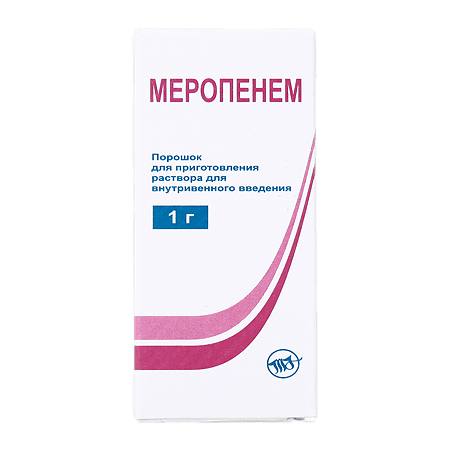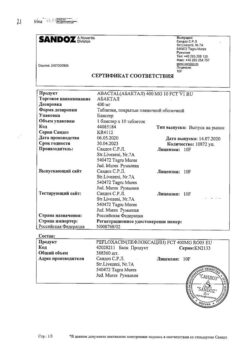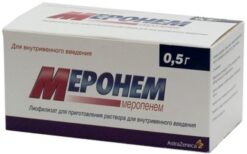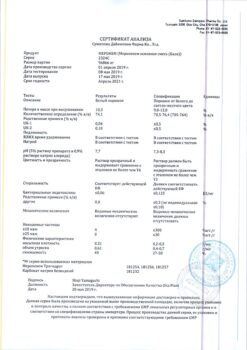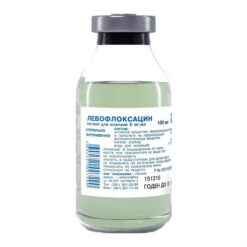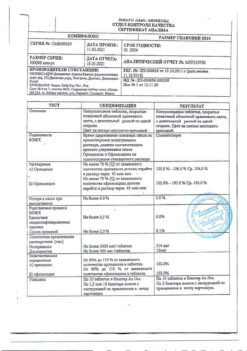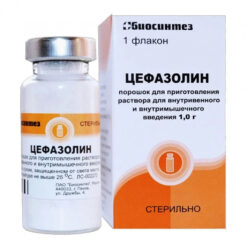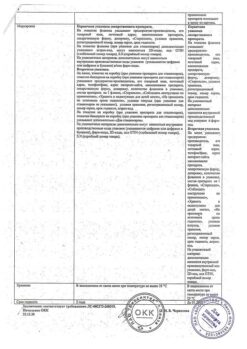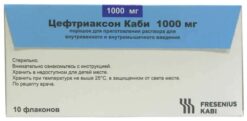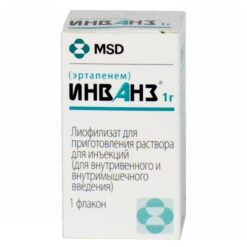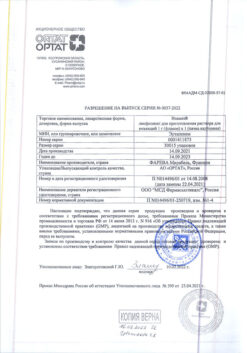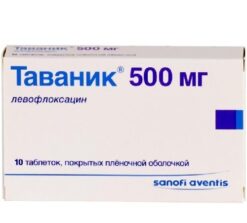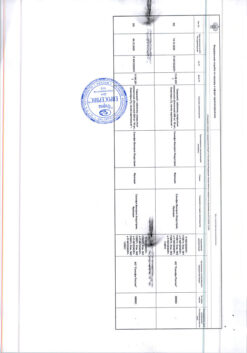No products in the cart.
Meropenem, 1 g
€1.00
Out of stock
(E-mail when Stock is available)
Description
Pharmacotherapeutic group:
An antibiotic, carbapenem
ATX code: J01DH02
Pharmacokinetics
Intravenous administration for 30 minutes of meropenem to healthy volunteers results in a maximum plasma concentration of approximately 11 µg/mL for the 250 mg dose, 23 µg/mL for the 500 mg dose and 49 µg/mL for the 1 g dose.
However, there is no absolute pharmacokinetic proportional relationship to the administered dose with respect to maximum concentration (C m ah ) and area under the pharmacokinetic concentration-time curve ( AUC ). A decrease in plasma clearance from 287 to 205 mL/min was observed for doses from 250 to 2 g.
Intravenous bolus injection of meropenem in healthy volunteers for 5 minutes results in a maximum plasma concentration of approximately 52 µg/mL for the 500 mg dose and 112 µg/mL for the 1 g dose.
6 hours after intravenous administration of 500 mg, plasma concentrations of meropenem decrease to values of 1 µg/ml or lower.
Longer infusion (up to 3 hours) of carbapenems may lead to optimization of their pharmacokinetic and pharmacodynamic parameters. When standard 30-minute ‑infusion in healthy volunteers of two doses of 500 and 2000 mg every 8 hours, the % T >MIC (ratio between the period of time when the drug concentration exceeds the MIC and the dosing interval; MIC=4 µg/ml) values were 30% and 58%, respectively. When the same doses were administered to volunteers by 3-hour infusion every 8 hours, the %T>MIC increased to 43% and 73% for 500 and 2000 mg, respectively. Mean plasma concentrations in healthy volunteers after intravenous bolus administration for 10 minutes of 1000 mg exceeded the MIC of 4 μg/mL for 42% of the dosing interval compared with 59% for a 3-hour infusion of 1000 mg.
Meropenem penetrates well into most tissues and body fluids, including the cerebrospinal fluid of patients with bacterial meningitis, reaching concentrations in excess of those required to suppress most bacteria.
There is no cumulation of the drug when repeated administration of meropenem at 8-hour intervals in patients with normal renal function. In patients with normal renal function the elimination half-life is approximately 1 hour. Binding to plasma proteins is approximately 2%.
About 70% of the intravenous dose of meropenem is excreted unchanged ‑by the kidneys within 12 hours, after which minor renal excretion is determined. Urinary concentrations of meropenem exceeding 10 µg/mL are maintained for hours after administration of a 500 mg dose. No cumulation of meropenem in plasma and urine was observed in volunteers with normal hepatic function when the regimens were administered 500 mg every 8 hours or 1 g every 6 hours.
The only metabolite of meropenem is microbiologically inactive.
Studies in children have shown that the pharmacokinetics of meropenem in children and adults are similar. The half-life of meropenem in children under 2 years of age is approximately 1.5-2.3 hours, with a linear relationship in the dose range of 10-40 mg kg.
Renal Impairment
Pharmacokinetic studies in patients with renal impairment have shown that meropenem clearance correlates with creatinine clearance. Dose adjustment is necessary in these patients.
A study of pharmacokinetics in the elderly showed decreased clearance of meropenem that correlated with age-related decreases in creatinine clearance.
Meropenem is excreted by hemodialysis with a clearance estimated to be 4 times that of meropenem in patients with anuria.
Hepatic impairment
Pharmacokinetics studies in patients with liver disease have shown that these pathological changes have no effect on the pharmacokinetics of meropenem.
Pharmacodynamics
Meropenem is an antibiotic of the carbapenem class, intended for parenteral administration, is relatively resistant to human dehydropeptidase-1 (HDP-1) and does not require additional HDP-1 inhibitor administration. Meropenem has a bactericidal effect due to its effect on the synthesis of the bacterial cell wall. High bactericidal activity of meropenem against a wide range of aerobic and anaerobic bacteria is explained by high ability of meropenem to penetrate through the bacterial cell wall, high level of stability to most beta-lactamases and significant affinity to various penicillin-binding proteins (PBPs).
The minimum bactericidal concentrations (MBCs) are generally the same as the minimum inhibitory concentrations (MICs). For 76% of the bacterial species tested, the MBC/MIR ratio was 2 or less.
In vitro tests show that meropenem acts synergistically with various antibiotics. In both in vitro and in vivo tests, meropenem has been shown to have a postantibiotic effect.
Microorganisms may have one or more of the following mechanisms of resistance to meropenem: disruption of the permeability of the cell wall of Gram-negative bacteria due to impaired porin synthesis; decrease in affinity to target PSBs; activation of efflux mechanisms; production of beta-lactamases that hydrolyze carbapenems.
The only recommended criteria for sensitivity to meropenem are based on the pharmacokinetics of the drug and on correlation of clinical and microbiological data – zone diameter and MIC determined for the corresponding pathogens.
Sensitivity to meropenem should be determined using standard methods. Interpretation of results should be performed according to local guidelines.
The efficacy of the drug against the pathogens listed below has been confirmed by clinical experience and antibiotic therapy guidelines. Pathogens susceptible to meropenem:
Gram-positive aerobes: Enterococcus faecalis1, Staphylococcus aureus (methicillin-sensitive‑)2, genus Staphylococcus ( methicillin-sensitive) including Staphylococcus epidermidis, Streptococcus agalactiae group B , group Streptococcus milleri (S. an ginosus, S. constellatus, S. intermedius ), Streptococcus pneumoniae , Streptococcus pyogenes group A.
Gram-negative aerobes: Citrobacter freudii, Citrobacter koseri, Enterobacter aerogenes. Enterobacter cloacae , Escherichia coli, Haemophilus influenzae , Klebsiella oxytoca, Klebsiella pneumoniae, Morganella morganii, Neisseria meningitidis , Proteus mirabilis, Proteus vulgaris, Serratia marcescens.
Gram-positive anaerobes: Clostridium perfringens, Peptoniphilus asaccharolyticus, genus Peptostreptococcus (including P. micros, P. anaerobius, P. magnus).
Gram-negative anaerobes: Bacteroides caccae, Bacteroides fragilis, Prevotella bivia , Prevotella disiens.
Pathogens for which the problem of acquired resistance is relevant:
Gram-positive aerobes: Enterococcu s faecium1.
Gram-negative aerobes: genus Acinetobacter , Burkholderia cepacia , Pseudomonas aeruginosa .
Pathogens with natural resistance:
Gram-negative aerobes: Stenotrophomonas maltophilia , Legionella spp .
Other pathogens: Chlamydophila pneumoniae , Chlamydophila psittaci, Coxiella burnetii. Mycoplasma pneumoniae.
1 – pathogens with intermediate sensitivity.
2 – all methicillin-resistant staphylococci are resistant to meropenem.
Indications
Indications
Infectious and inflammatory diseases (monotherapy or in combination with other antimicrobial drugs) caused by pathogens sensitive to meropenem:
lower respiratory tract infections (including pneumonia, including hospital-acquired);
abdominal infections (complicated appendicitis, peritonitis, pelvioperitonitis);
urinary tract infections (pyelonephritis, pyelitis);
infections of the skin and soft tissues (including erysipelas, impetigo, secondary infected dermatoses);
infections of the pelvic organs (including endometritis);
bacterial meningitis;
septicemia;
empirical treatment (as monotherapy or in combination with antiviral or antifungal drugs) for suspected infection in adult patients with febrile neutropenia.
Pharmacological effect
Pharmacological effect
Pharmacotherapeutic group:
Antibiotic, carbapenem
ATX code: J01DH02
Pharmacokinetics
Intravenous administration of meropenem over 30 minutes to healthy volunteers results in maximum plasma concentrations of approximately 11 mcg/mL for a 250 mg dose, 23 mcg/mL for a 500 mg dose, and 49 mcg/mL for a 1 g dose.
However, with respect to the maximum concentration (C m ax ) and the area under the concentration-time pharmacokinetic curve (AUC), there is no absolute pharmacokinetic proportional relationship to the administered dose. There was a decrease in plasma clearance from 287 to 205 ml/min for doses from 250 to 2 g.
An intravenous bolus injection of meropenem over 5 minutes into healthy volunteers results in maximum plasma concentrations of approximately 52 mcg/mL for the 500 mg dose and 112 mcg/mL for the 1 g dose.
6 hours after intravenous administration of 500 mg, the concentration of meropenem in the blood plasma decreases to values of 1 mcg/ml and below.
Extended (up to 3 hours) infusion of carbapenems can lead to optimization of their pharmacokinetic and pharmacodynamic parameters. With a standard 30-minute infusion in healthy volunteers of two doses of 500 and 2000 mg every 8 hours, the % T >MIC (the ratio between the period of time when the drug concentration exceeds the MIC and the dosing interval; MIC = 4 μg/ml) was 30% and 58%, respectively. When the same doses were administered to volunteers by 3-hour infusion every 8 hours, the %T>MIC increased to 43 and 73%, for 500 and 2000 mg, respectively. The mean plasma concentration in healthy volunteers following a 10-minute intravenous bolus of 1000 mg exceeded the MIC of 4 mcg/mL for 42% of the dosing interval compared with 59% for a 3-hour infusion of 1000 mg.
Meropenem penetrates well into most body tissues and fluids, including the cerebrospinal fluid of patients with bacterial meningitis, reaching concentrations greater than those required to inhibit most bacteria.
With repeated administration of meropenem at intervals of 8 hours to patients with normal renal function, no accumulation of the drug is observed. In patients with normal renal function, the half-life is approximately 1 hour. Plasma protein binding is approximately 2%.
About 70% of an intravenous dose of meropenem is excreted unchanged by the kidneys within 12 hours, after which negligible renal excretion is detected. Concentrations of meropenem in urine exceeding 10 mcg/ml. maintained for hours after administration of the 500 mg dose. With dosing regimens of 500 mg every 8 hours or 1 g every 6 hours, no accumulation of meropenem in plasma or urine was observed in volunteers with normal liver function.
The only metabolite of meropenem is microbiologically inactive.
Studies in children have shown that the pharmacokinetics of meropenem are similar in children and adults. The half-life of meropenem in children under 2 years of age is approximately 1.5–2.3 hours, with a linear relationship observed over the dose range of 10–40 mg kg.
Kidney failure
Pharmacokinetic studies in patients with renal failure have shown that meropenem clearance correlates with creatinine clearance. In such patients, dose adjustment is necessary.
Pharmacokinetic studies in elderly subjects revealed a decrease in meropenem clearance, which correlated with an age-related decrease in creatinine clearance.
Meropenem is eliminated by hemodialysis with a clearance approximately 4 times higher than the clearance of meropenem in anuric patients.
Liver failure
Pharmacokinetic studies in patients with liver disease have shown that these pathological changes do not affect the pharmacokinetics of meropenem.
Pharmacodynamics
Meropenem is an antibiotic of the carbapenem class, intended for parenteral administration, relatively resistant to human dehydropeptidase-1 (DHP-1), and does not require additional administration of a DHP-1 inhibitor. Meropenem has a bactericidal effect due to its effect on the synthesis of the bacterial cell wall. The high bactericidal activity of meropenem against a wide range of aerobic and anaerobic bacteria is explained by the high ability of meropenem to penetrate the bacterial cell wall, a high level of stability to most beta-lactamases and significant affinity for various penicillin-binding proteins (PBPs).
Minimum bactericidal concentrations (MBCs) are usually the same as minimum inhibitory concentrations (MICs). For 76% of the bacterial species tested, the MBC/MIC ratio was 2 or less.
In vitro tests show that meropenem acts synergistically with various antibiotics. In vitro and in vivo tests have shown that meropenem has a post-antibiotic effect.
Microorganisms may have one or more of the following mechanisms of resistance to meropenem: impaired permeability of the cell wall of gram-negative bacteria due to impaired porin synthesis; decreased affinity for target PBPs; activation of efflux mechanisms; production of beta-lactamases, under the influence of which hydrolysis of carbapenems occurs.
The only recommended criteria for sensitivity to meropenem are based on the pharmacokinetics of the drug and on the correlation of clinical and microbiological data – zone diameter and MIC determined for the relevant pathogens.
Susceptibility to meropenem should be determined using standard methods. Interpretation of results should be done in accordance with local guidelines.
The effectiveness of the drug against the pathogens listed below is confirmed by clinical experience and guidelines for antibacterial therapy. Pathogens sensitive to meropenem:
Gram-positive aerobes: Enterococcus faecalis1, Staphylococcus aureus (methicillin-sensitive)2, genus Staphylococcus (methicillin-sensitive), including Staphylococcus epidermidis, Streptococcus agalactiae group B, group Streptococcus milleri (S. an ginosus, S. constellatus, S. intermedius), Streptococcus pneumoniae, Streptococcus pyogenes group A.
Gram-negative aerobes: Citrobacter freudii, Citrobacter koseri, Enterobacter aerogenes. Enterobacter cloacae, Escherichia coli, Haemophilus influenzae, Klebsiella oxytoca, Klebsiella pneumoniae, Morganella morganii, Neisseria meningitidis, Proteus mirabilis, Proteus vulgaris, Serratia marcescens.
Gram-positive anaerobes: Clostridium perfringens, Peptoniphilus asaccharolyticus, genus Peptostreptococcus (including P. micros, P. anaerobius, P. magnus).
Gram-negative anaerobes: Bacteroides caccae, Bacteroides fragilis, Prevotella bivia, Prevotella disiens.
Pathogens for which the problem of acquired resistance is relevant:
Gram-positive aerobes: Enterococcus faecium1.
Gram-negative aerobes: genus Acinetobacter, Burkholderia cepacia, Pseudomonas aeruginosa.
Pathogens with natural resistance:
Gram-negative aerobes: Stenotrophomonas maltophilia, Legionella spp.
Other pathogens: Chlamydophila pneumoniae, Chlamydophila psittaci, Coxiella burnetii. Mycoplasma pneumoniae.
1 – pathogens with intermediate sensitivity.
2 – all methicillin-resistant staphylococci are resistant to meropenem.
Special instructions
Special instructions
Treatment of patients with liver diseases should be carried out under careful monitoring of the activity of “liver” transaminases and bilirubin concentration. During treatment, pathogen resistance may develop, and therefore long-term treatment is carried out under constant monitoring of the spread of resistant strains.
In persons with diseases of the gastrointestinal tract, especially colitis, it is necessary to consider the possibility of developing pseudomembranous colitis (the toxin produced by Clostridium difficile is one of the main causes of colitis associated with antibiotics), the first symptom of which may be the development of diarrhea during treatment.
When using meropenem as monotherapy in critically ill patients with known or suspected lower respiratory tract infection caused by Pseudomonas aeruginosa, regular meropenem susceptibility testing is recommended.
There is no experience with the use of the drug in children with neutropenia or with primary or secondary immunodeficiency.
Active ingredient
Active ingredient
Meropenem
Composition
Composition
1 bottle contains:
Active substance:
1 g meropenem.
Excipients:
sodium carbonate anhydrous 208 mg.
Pregnancy
Pregnancy
Pregnancy
The safety of meropenem in women during pregnancy has not been studied. Animal studies have not shown any adverse effects on the developing fetus.
Meropenem should not be used during pregnancy unless the potential benefit to the mother outweighs the potential risk to the fetus. In each case, the drug must be used under the strict supervision of a physician.
Breastfeeding period
Data have been obtained on the excretion of meropenem in breast milk. Meropenem should not be used during breastfeeding unless the potential benefit to the mother from the drug outweighs the possible risk to the baby. Having assessed the benefit for the mother, a decision should be made to stop breastfeeding or discontinue the drug.
Contraindications
Contraindications
History of hypersensitivity to meropenem or other beta-lactam antibiotics, children under 3 months of age.
With caution
Simultaneous administration with potentially nephrotoxic drugs.
Persons with complaints from the gastrointestinal tract (including colitis).
Side Effects
Side Effects
From the digestive system: pain in the epigastric region, nausea, vomiting, diarrhea, constipation, anorexia, jaundice, cholestatic hepatitis, hyperbilirubinemia, increased activity of liver transaminases, alkaline phosphatase, lactate dehydrogenase; rarely – candidiasis of the oral mucosa, pseudomembranous colitis.
From the cardiovascular system: development or worsening of heart failure, cardiac arrest, tachy- or bradycardia, decreased or increased blood pressure, fainting, myocardial infarction, thromboembolism of the branches of the pulmonary artery.
From the urinary system: dysuria, edema, impaired renal function (hypercreatininemia, increased concentration of urea in plasma), hematuria.
Allergic reactions: skin itching, skin rash, urticaria, erythema multiforme (Stevens-Johnson syndrome), angioedema, anaphylactic shock.
From the nervous system: headache, dizziness, paresthesia, insomnia, drowsiness, increased excitability, agitation, anxiety, depression, impaired consciousness, hallucinations, epileptiform seizures, convulsions.
Laboratory indicators: eosinophilia, neutropenia, leukopenia, rarely – agranulocytosis, hypokalemia, leukocytosis, reversible thrombocytopenia, decreased partial thromboplastin time, anemia.
Local reactions: inflammation, phlebitis, thrombophlebitis, pain at the injection site.
Other: positive direct or indirect Coombs test, hypervolemia, shortness of breath, vaginal candidiasis/
Interaction
Interaction
Probenecid competes with meropenem for active tubular secretion and thus inhibits the renal excretion of meropenem, causing an increase in its half-life and plasma concentration (simultaneous use is not recommended).
Use the drug Meropenem only as prescribed by a doctor, instructions are given for reference!
Overdose
Overdose
Overdose is possible during treatment, especially in patients with impaired renal function.
Treatment: carry out symptomatic therapy.
Normally, the drug is rapidly eliminated through the kidneys.
In patients with impaired renal function, hemodialysis effectively removes meropenem and its metabolite.
Storage conditions
Storage conditions
In a place protected from light, at a temperature not exceeding 25 °C.
Shelf life
Shelf life
2 years
Manufacturer
Manufacturer
Biopharm LLC, Russia
Additional information
| Shelf life | 2 years |
|---|---|
| Conditions of storage | In a light-protected place at a temperature not exceeding 25 °C. |
| Manufacturer | Biopharm, Russia |
| Medication form | Powder for preparation of solution |
| Brand | Biopharm |
Related products
Buy Meropenem, 1 g with delivery to USA, UK, Europe and over 120 other countries.

